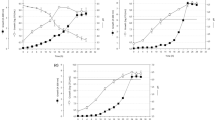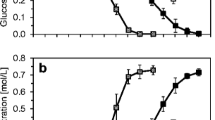Abstract
Objective
The growth characteristics and intracellular hemin concentrations of Lactococcus lactis grown under different culture pH and aeration conditions were examined to investigate the effect of culture pH on the respiration efficiency of L. lactis NZ9000 (pZN8148).
Results
Cell biomass and biomass yield of L. lactis grown with 4 μg hemin/ml and O2 were higher than those without aeration when the culture pH was controlled at 5–6.5. The culture pH affected the respiratory efficiency in the following order of pH: 5 > 5.5 > 6 > 6.5; the lag phase increased as the culture pH decreased. Hemin accumulation was sensitive to culture pH. Among the four pH conditions, pH 5.5 was optimal for hemin accumulation in the cells. The highest intracellular hemin level in L. lactis resting cells incubated at different pH saline levels (5–6.5) was at pH 5.5.
Conclusion
The respiration efficiency of L. lactis under respiration-permissive conditions increases markedly as the culture pH decreases. These results may help develop high cell-density L. lactis cultures. Thus, this microorganism may be used for industrial applications.




Similar content being viewed by others
References
Bahey-El-Din M, Gahan CGM, Griffin BT (2010) Lactococcus lactis as a cell factory for delivery of therapeutic proteins. Curr Gene Ther 10:34–45
Brooijmans RJW, Poolman B, Schuurman-Wolters GK, de Vos WM, Hugenholtz J (2007) Generation of a membrane potential by Lactococcus lactis through aerobic electron transport. J Bacteriol 189:5203–5209
Gaudu P, Vido K, Cesselin B, Kulakauskas S, Trembly J, Rezaiki L, Lamberet G, Sourice S, Duwat P, Gruss A (2002) Respiration capacity and consequences in Lactococcus lactis. Antonie Van Leeuwenhoek 82:263–269
Honsa ES, Maresso AW (2011) Mechanisms of iron import in anthrax. Biometals 24:533–545
Joubert L, Derré-Bobillot A, Gaudu P, Gruss A, Lechardeur D (2014) HrtBA and menaquinones control haem homeostasis in Lactococcus lactis. Mol Microbiol 93:823–833
Lombardo ME, Araujo LS, Ciccarelli AB, Batlle A (2005) A spectrophotometric method for estimating hemin in biological systems. Anal Biochem 341:199–203
Mazmanian SK, Skaar EP, Gaspar AH, Humayun M, Gornicki P, Jelenska J, Joachmiak A, Missiakas DM, Schneewind O (2003) Passage of heme-iron across the envelope of Staphylococcus aureus. Science 7:906–909
Nagayasu M, Wardani AK, Nagahisa K, Shimizu H, Shioya S (2007) Analysis of hemin effect on lactate reduction in Lactococcus lactis. J Biosci Bioeng 103:529–534
Nitzan Y, Laden H, Malik Z (1987) Growth-inhibitory effect of hemin on Staphylococci. Curr Microbiol 14:279–284
Pedersen MB, Iversen SL, Sorensen KI, Johansen E (2005) The long and winding road from the research laboratory to industrial applications of lactic acid bacteria. FEMS Microbiol Rev 29:611–624
Pedersen MB, Garrigues C, Tuphile K, Brun C, Vido K, Bennedsen M, Møllgaard H, Gaudu P, Gruss A (2008) Impact of aeration and heme-Activated respiration on Lactococcus lactis gene expression: identification of a heme-responsive operon. J Bacteriol 190:4903–4911
Pontes DS, de Azevedo MSP, Chatel JM, Langella P, Azevedo V, Miyoshi A (2011) Lactococcus lactis as a live vector: heterologous protein production and DNA delivery systems. Protein Expr Purif 79:165–175
Reniere ML, Torres VJ, Skaar EP (2007) Intracellular metalloporphyrin metabolism in Staphylococcus aureus. Biometals 7:333–345
Sawai H, Yamanaka M, Sugimoto H, Shiro Y, Aono S (2012) Heme-responsive regulatory mechanism of HrtR responsible for transcriptional regulation of heme homeostasis. J Biol Chem 287:30755–30768
Acknowledgments
This work was supported by the National Natural Sciences Foundation of China (Contract No. 31200034) and the Foundation of Human Resourance of Anhui Agricultural University. We thank Dr. Jeroen Hugenholtz for providing strain NZ9000 and plasmid pNZ8148.
Author information
Authors and Affiliations
Corresponding author
Rights and permissions
About this article
Cite this article
Shi, W., Li, Y., Gao, X. et al. Improvement of the respiration efficiency of Lactococcus lactis by decreasing the culture pH. Biotechnol Lett 38, 495–501 (2016). https://doi.org/10.1007/s10529-015-1999-6
Received:
Accepted:
Published:
Issue Date:
DOI: https://doi.org/10.1007/s10529-015-1999-6




